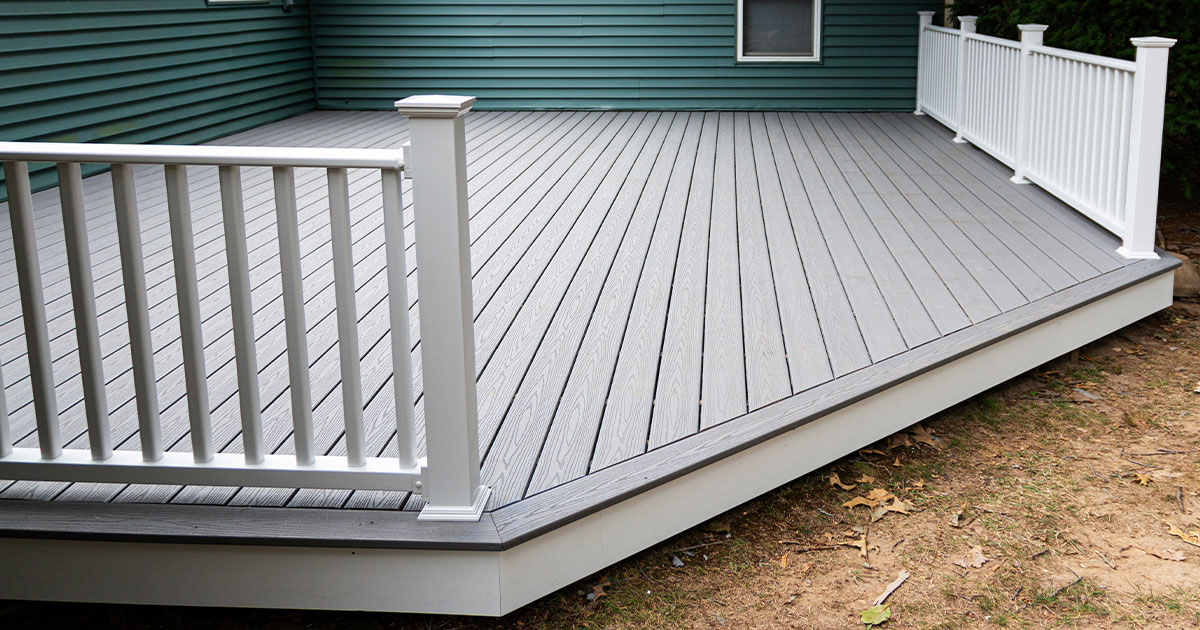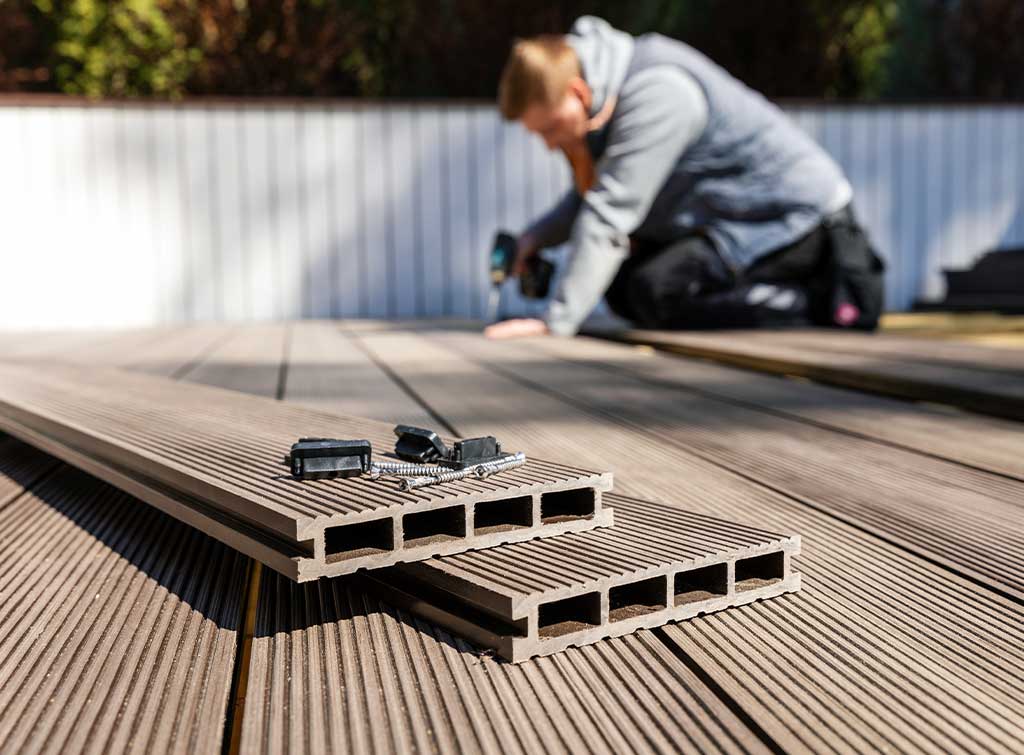Exactly how to Pick the Right Products for Your Deck Installation Task
Choosing the appropriate materials for your deck setup task can appear challenging. There are countless aspects to consider, from longevity and maintenance to aesthetics and ecological effect. The selection between traditional timber and composite materials, each with its very own collection of advantages and drawbacks, can be specifically tough. The trick is to balance your budget plan, layout preferences, and way of life needs to create a deck that will certainly improve your exterior area for many years ahead.
Understanding the Different Sorts Of Deck Materials
When getting started on a deck installment project, the choice of materials comes to be a critical choice. Different options are offered, each with special qualities and visual charm. Typical timber, for example, offers a timeless, all-natural appearance and is generally a lot more cost-efficient. It can warp over time and requires routine maintenance. Composite materials, on the other hand, are a mix of timber and plastic, offering sturdiness and resistance to weather elements. They demand much less upkeep compared to timber yet are generally more pricey. One more choice is plastic, which is essentially maintenance-free and immune to insects and rot, albeit much less natural-looking. By recognizing these differences, property owners can make a more informed decision on one of the most ideal deck product for their certain requirements.
Assessing the Sturdiness and Upkeep Requirements of Deck Products
Analyzing the longevity and maintenance requirements of deck products is a vital action in deck setup. Durability involves the material's ability to endure rough weather condition conditions, wear and tear, and its long life.
Understanding upkeep requirements is similarly important. Some products need routine sealing or discoloring to keep their appearance and withstand dampness damages, while others, like composite outdoor decking, require much less upkeep. By examining these aspects, one can choose one of the most suitable outdoor decking product, guaranteeing a balance in between resilience, upkeep needs, and visual charm.
Expense Evaluation: Comparing Timber and Composite Decking
Although cost may initially seem like a secondary concern, it is a significant variable when contrasting wood and composite decking. Timber, normally a cheaper choice, has a lower ahead of time price. Nonetheless, with time, upkeep expenditures can build up, possibly making wood much more expensive over time. These maintenance prices might consist of discoloration, securing, or replacing damaged boards. On the various other hand, composite outdoor decking, while pricier initially, needs much less maintenance, potentially reducing lasting expenses. It's vital to remember that composite decking isn't resistant to put on and tear, and substitute prices can be high. Therefore, possible deck owners must consider their budget and determination to maintain their decks when choosing in between wood and composite outdoor decking.
Looks and Layout Flexibility of Decking Products
While price is a vital consideration, the aesthetic charm and layout versatility of outdoor decking materials additionally play a considerable duty in the decision-making process. Different products offer differing levels of visual appeal. All-natural wood decking gives a traditional, classic appearance, while composite materials supply a vast variety of colors and textures to suit diverse tastes and designs. In a similar way, design adaptability refers to the capacity to form and adjust the decking product to fulfill specific design needs. Wood, as an example, uses high style versatility due to its simplicity of reducing and forming. Compound materials, while much less versatile in layout, are still adaptable enough for most deck designs. These variables, for that reason, are important determinants in the selection of decking material.
Environmental Influence of Decking Products
When choosing decking products, one have to think about not only aesthetics and sturdiness, however also the ecological effect. It is essential to assess the sustainability of products and explore recycled outdoor decking alternatives. Comprehending the potential influence on regional communities will certainly ensure a more environmentally responsible option.
Examining Product Sustainability
In the realm of deck building, analyzing material sustainability is an important step. This involves evaluating the environmental influence of each prospective material, thinking about variables such as the energy needed for its this page manufacturing, its carbon impact, and its end-of-life disposal or reusing choices. Timber is an eco-friendly source, but unsustainable logging methods can lead to deforestation. Additionally, composite outdoor decking materials typically integrate timber and plastic, reducing the need for new timber however enhancing reliance on fossil gas. Light weight aluminum and other steels might be extra sturdy and recyclable, however their extraction and processing can be energy-intensive. Hence, the option of decking products ought to stabilize performance, looks, expense, and sustainability to make certain a liable and durable setup.
Recycled Outdoor Decking Options

Compound outdoor decking is especially popular because of its sturdiness and simplicity of maintenance. It's immune to rot, insects, and fading, making it a resilient option. Recycled plastic outdoor decking, on the other hand, is highly resilient and requires marginal maintenance. While my company these products might bring a greater initial price, their long life and lowered ecological impact make them a wise investment for the eco-conscious house owner.

Effect On Local Environments
While the benefits of utilizing recycled products for decking can not be overemphasized, it's equally important to consider the broader ecological ramifications of these options. The extraction, handling, and transport of materials can profoundly influence regional ecosystems. Logging for hardwood decking adds to environment loss and environment adjustment. Also the production of composite products can release damaging emissions. Alternatively, making use of recycled or sustainably sourced products can assist minimize these results. Moreover, thinking about the lifespan of products can reduce ecological impact; longer-lasting options call for less frequent substitute, hence preserving resources. Proper disposal of old decking is essential to lessening garbage dump waste. Basically, an eco-conscious deck task demands cautious material choice, lasting sourcing, and accountable disposal.
Making Your Final Choice: Tips for Picking the Ideal Deck Products
As the post shifts right into the subtopic of "Making Your Decision: Tips for Choosing the Ideal Deck Products", it is vital to recognize the range of deck products available. Striking a balance in between sturdiness and aesthetics is necessary in this option procedure. The following conversation will certainly lead viewers in making an educated option based on these key factors to consider.
Comprehending Various Deck Materials
The job of choosing the right materials for your deck installation can appear intimidating due to the substantial selection of choices available. Comprehending the different materials can simplify this process. Wood is a popular option, offering a traditional aesthetic and cost. Sorts of timber utilized consist of pressure-treated lumber, cedar, and redwood. Compound products, made from a blend of timber and plastic, are low-maintenance and immune to rot and bugs. Vinyl or PVC decks are much more resilient and call for less maintenance than composite products, but they can look much less all-natural. Finally, light weight aluminum decks are strong, lightweight, and immune to rot, yet they are also the most costly choice. Each material has its own advantages and drawbacks, making it vital to consider your details requirements before making a decision.
Resilience vs. Aesthetics Balance
Stabilizing sturdiness with visual appeals can be an obstacle when choosing deck materials - deck installer austin. High-traffic areas might necessitate resilient products like composite outdoor decking, which withstands wear and tear but might lack the natural appeal of timber. Property owners need to strike an equilibrium, considering both the deck's practical needs and their aesthetic choices.
Conclusion
Finally, choosing the appropriate materials for your deck installment project needs mindful factor to consider of variables such as durability, maintenance, cost, visual appeals, and environmental influence. Whether you choose traditional wood or composite products, your selection needs to align with your spending plan, style preferences, and way of living. Eventually, the very best outdoor decking material is one that boosts your outdoor area and gives page pleasure for several years ahead.